OmniPlan Preferences
OmniPlan Preferences contain a variety of useful configuration options for interacting with OmniPlan and customizing its display and behavior to suit your needs. Preferences are accessible in-app from the OmniPlan menu or with the keyboard shortcut (Command-,).
General Preferences
The first OmniPlan Preferences pane provides customization of the Tab and Return keys to suit your preferred method of keyboard navigation.
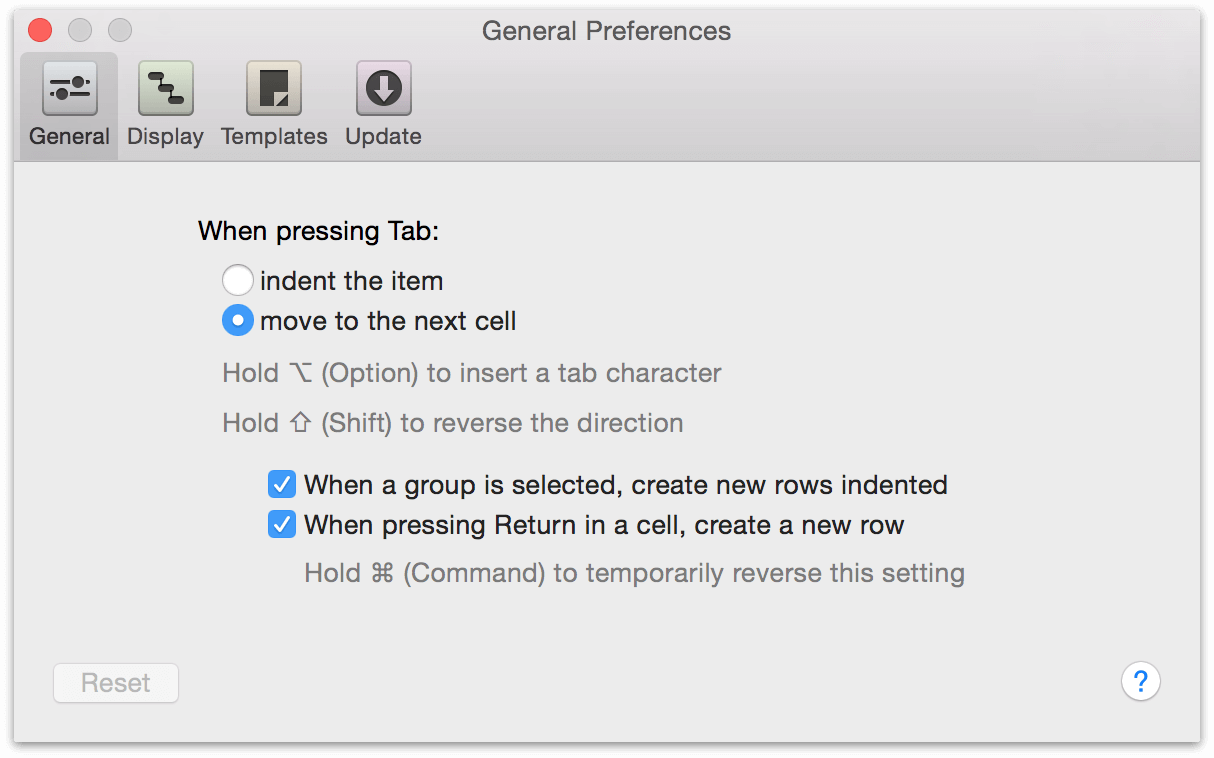
When pressing Tab — You can set the Tab key to do one of two things:
Indent the currently selected item in the outline, thus making it a child of the item above it. Pressing Shift-Tab outdents the selected item.
Move to the next cell in the outline. Pressing Shift-Tab moves to the previous cell.
Either way, the Indent and Outdent commands in the Structure menu (and their keyboard shortcuts, Command-[ or Command-] by default) will always work.
You can always press Option-Tab to type a tab character at the insertion point.
When pressing Return in a cell, create a new row — When you are done editing the contents of a cell in the outline, you might press Return to finish editing. If this preference is turned on, a new item is then created. Otherwise, the editing just ends and the current item becomes selected.
Whether this setting is on or off, pressing Return while not editing a cell always creates a new item.
You can hold Command while pressing Return to temporarily change the setting; for example you could press Command-Return to finish editing and create a new item, even if the setting was turned off.
Display Preferences
The Display preferences are the second pane of Preferences, and control the display of times and dates throughout OmniPlan.
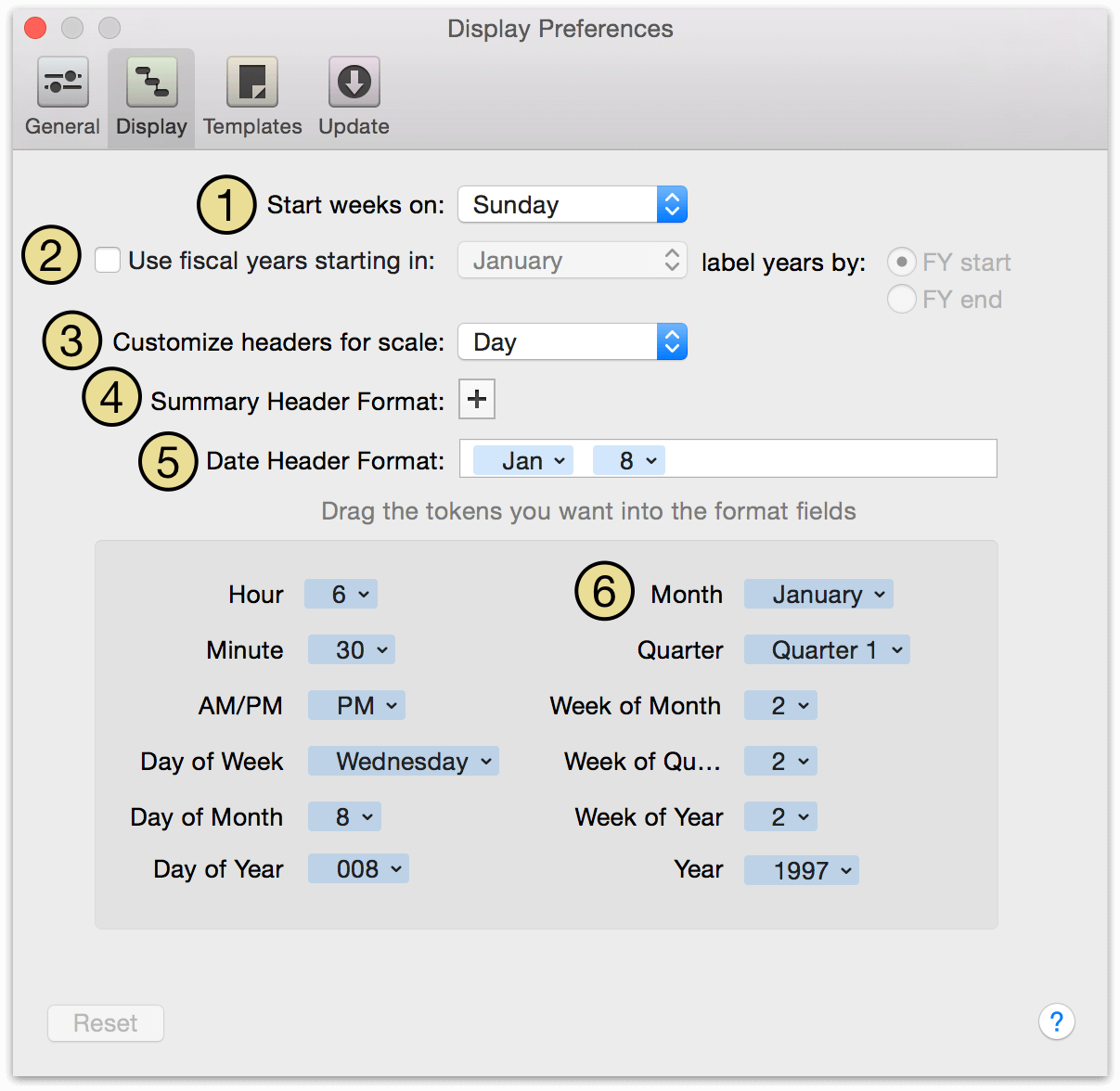
Choose which day OmniPlan should consider as the first day of the week.
Turn on Fiscal Years and specify when they start or end. Using Fiscal Years changes the way quarters (Quarter 1, Quarter 2, etc.) of your year are calculated and displayed in the date headers of the Gantt chart.
This pop-up menu determines which chart header scale you’ll be editing below. The different time scales appear in the headers of the Gantt chart, resource timeline, and work week chart, depending on the zoom scale.
Click the plus button to add a summary header to the current scale. This makes an extra layer of date headers above the normal one in the Gantt chart and the resource timeline. This extra layer gives you more room to show, for instance, the week above the day, or the month above the week. The summary header format can be customized in the same way as the regular date header format, by dragging tokens from the box below and by typing directly into the field. To get rid of the summary header, just click the minus button to the right of the field.
Here’s where you can assemble a date format. Drag tokens from the box below, and type spaces or characters wherever you want them to appear. Some tokens offer information about the date at the beginning or end of a week or quarter. This is so that you can, for example, create a week format which indicates the first and last days of the week. Here we have a format that displays the short name of the month, followed by the date.
Tokens can be dragged to the format field above to construct a date format. Click the triangle on the right side of a token to change the display of the token. For example, this token represents the month; you can choose to display the month as a full word (January), an abbreviation (Jan), a two-digit number (01), or a one-digit number (1).
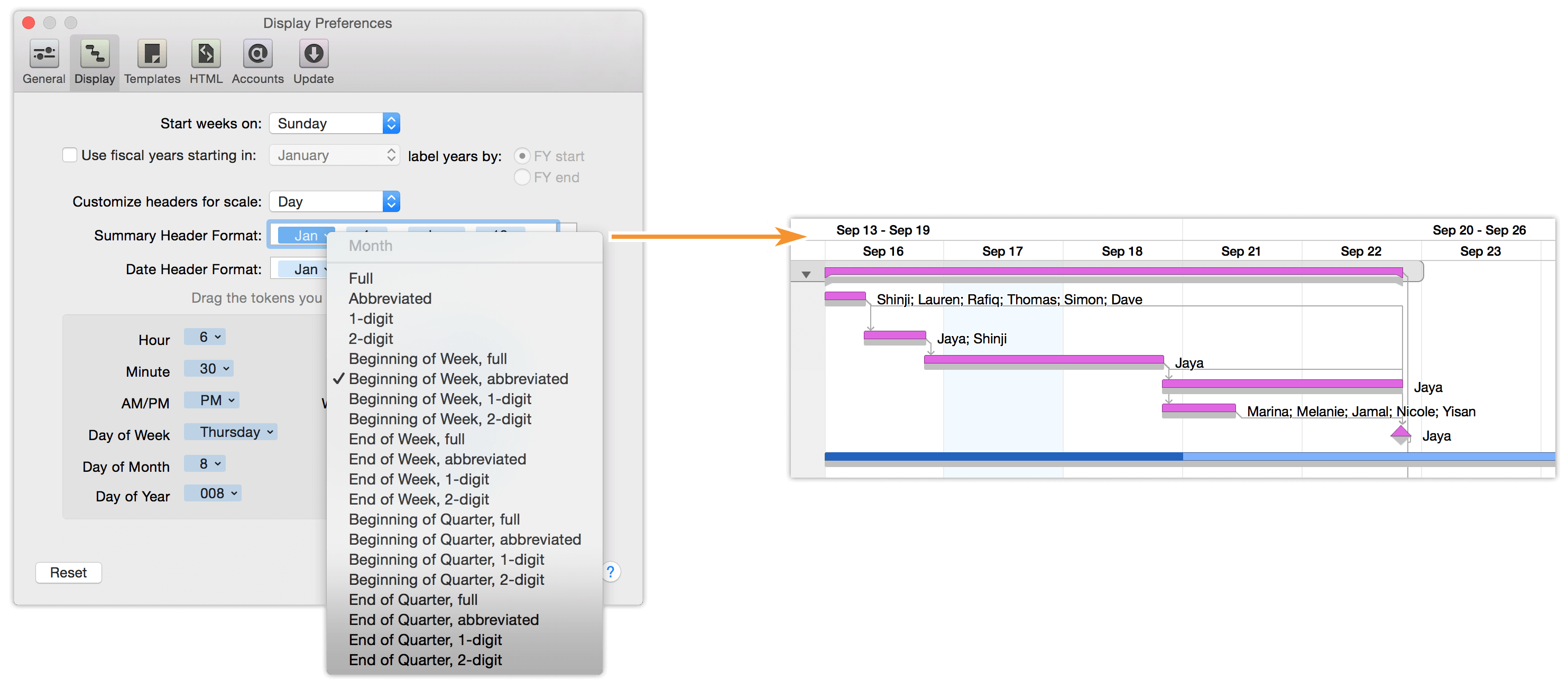
Templates Preferences
A template is a file set up just right to be a starting point for a new project. For example, there might be certain resources you use for every project, a common task structure, certain named styles you like to use, and a standard set of working hours for your company. You can configure all of these things once, then create new documents from that template.
The Templates pane of Preferences provides a list of included templates that you can use as the source for a new document. Two are included with the app by default (a completely empty plan and one set up with Automatic Leveling turned on), and you can create your own from a currently open plan by choosing File ▸ Save as Template from the File menu.
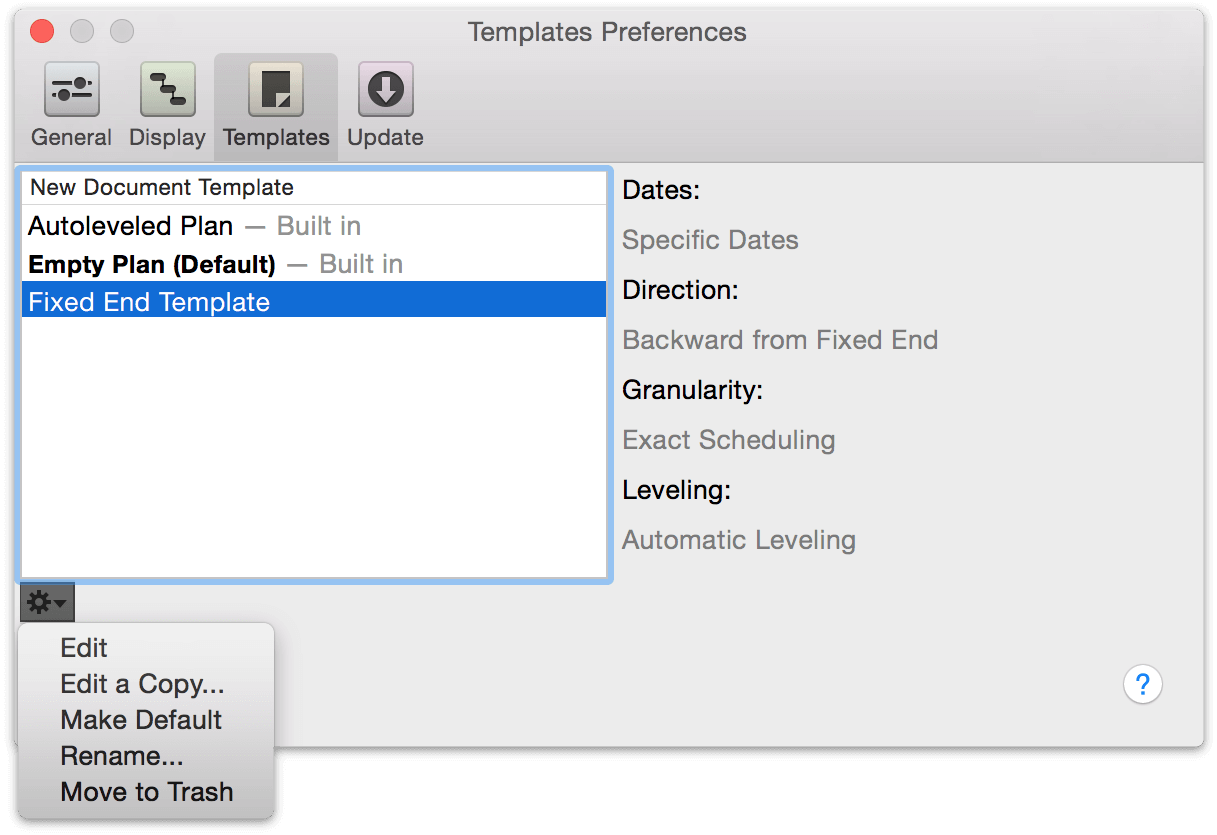
Edit the list of available templates using the gear menu beneath the document list. If there are settings you use frequently for new project files, you can choose a template to set as the default; otherwise, create new projects from templates by choosing File ▸ New From Template... from the File menu.
From the gear menu below the list, you can:
Edit: Change the selected template. You can also just double-click the template’s name in the list. When you save your changes, the template is updated.
Edit a Copy: Make a different version of the selected template. Select this command, type a title for the new template, then change the document and save it as usual.
Make Default: Use the selected template from now on when making new documents with the File ▸ New command. The template’s entry in the list changes to bold type.
Rename: Change the title of the selected template.
Move to Trash: Get rid of the selected template by putting it in the trash. From there, you can still recover it if you need it. Otherwise, it will be deleted the next time you empty the trash.
Note
If you’d like to reuse a specifically configured task multiple times within the same project, you can "template" tasks on the fly by selecting the task you’d like to duplicate and choosing Project ▸ Set As Default For New Tasks. Subsequently created new tasks will match the settings of the one you chose.
Creating a Template
Create a new document normally with File ▸ New.
Set up the document however you like. Everything about a document, including its contents, the state of the Project inspector, the view options, and so on, can be saved to a template.
Once the document is ready, choose File ▸ Save As Template.

Enter a name for the template and confirm it.
When you create a document using File ▸ New, your new document follows the default template. To use a different template, use the File ▸ New From Template submenu instead.

HTML Preferences (Pro)
With OmniPlan Pro, printing from the Report window and HTML export of OmniPlan files rely on a set of HTML and CSS files that together form a template describing how the destination document should look. The HTML Preferences lists the available export templates, and provides tools for creating new ones.
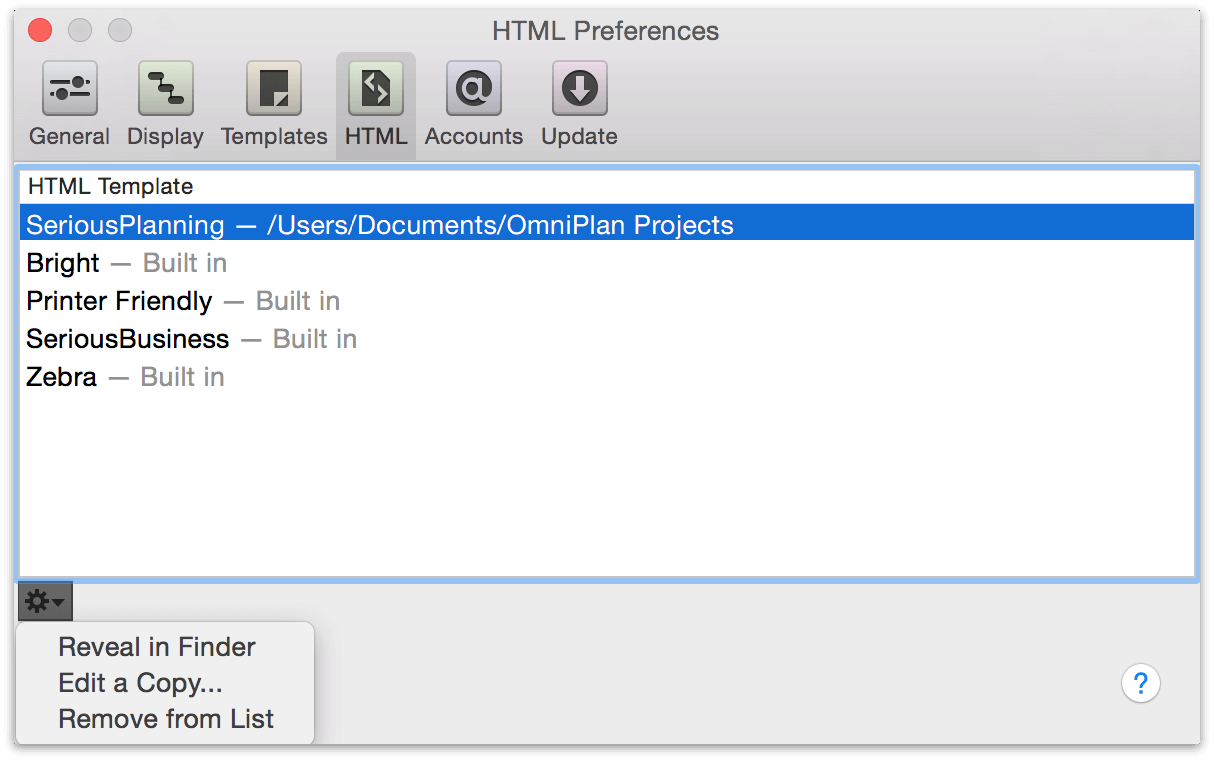
Several great templates are included with the app, but if you’d prefer to customize the appearance and presentation of your project when printing or exporting, you can create a new copy of an HTML template from the gear menu on this pane, save the copy in a folder you designate, and edit the HTML and CSS to suit your needs.
Template integration with OmniPlan’s custom data types is done via tokens. A guide to setting up your own custom reporting templates is available in the Customizing Reporting Templates (Pro) section of the Reporting and Printing chapter, along with a reference list of the tokens used to fetch specific data from OmniPlan.
Accounts Preferences (Pro)
When multiple users will be contributing to and editing an OmniPlan project, with OmniPlan Pro you can easily keep everyone on the same page by syncing the project to a server repository. You’ll set up your server account here, in the Accounts pane of Preferences.
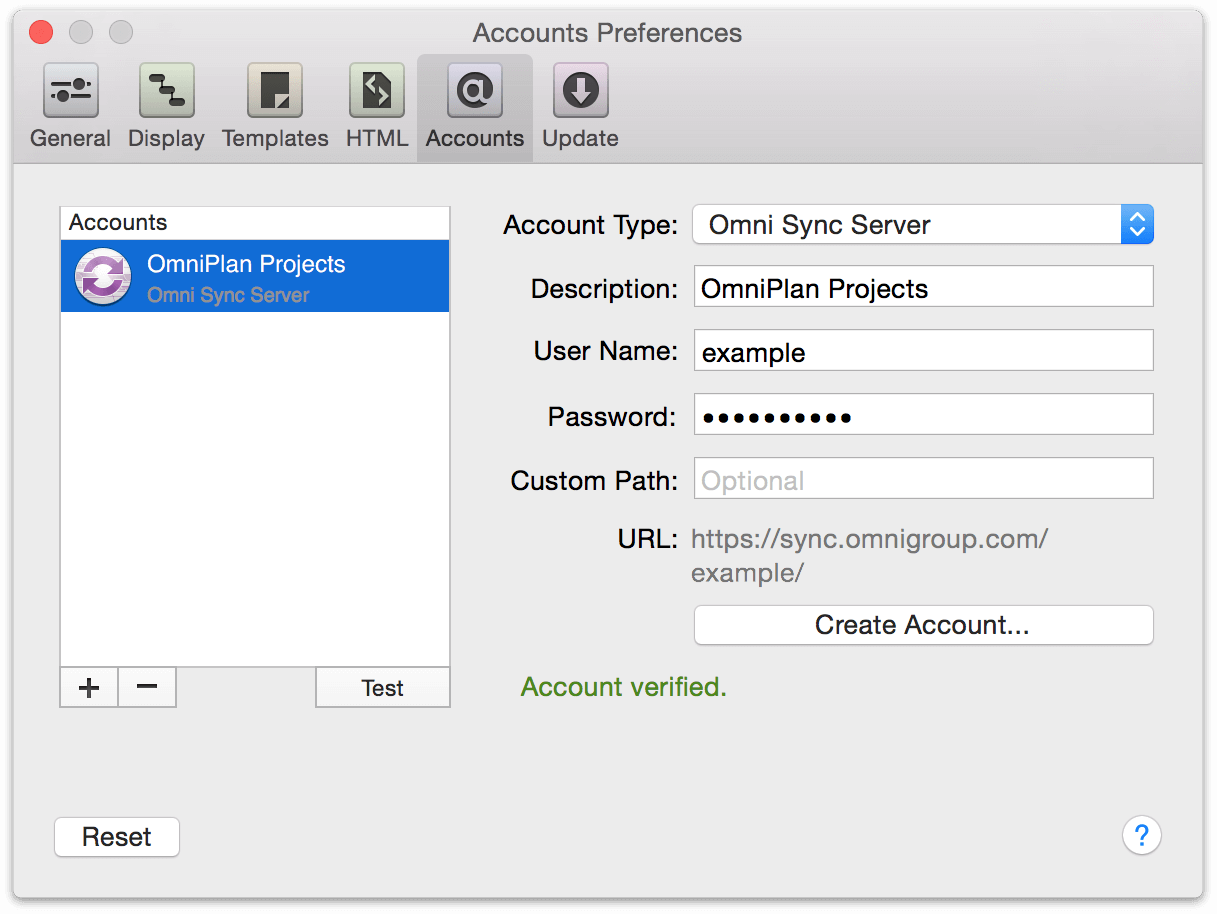
OmniPlan supports the open WebDAV standard, and also offers Omni Sync Server as a recommended option for publishing and subscribing to your shared projects. A quick start guide to getting synced can be found in the Collaborating with Multiple Contributors section of the manual.
Tip
Publication and Subscription is the only supported way to sync with OmniPlan for iOS, so if that’s a priority for your workflow it’s a good idea to check it out.
Update Preferences
OmniPlan can automatically use your internet connection to check for new and updated versions of itself; you can get to these options by choosing Preferences from the OmniPlan menu, then clicking Update.
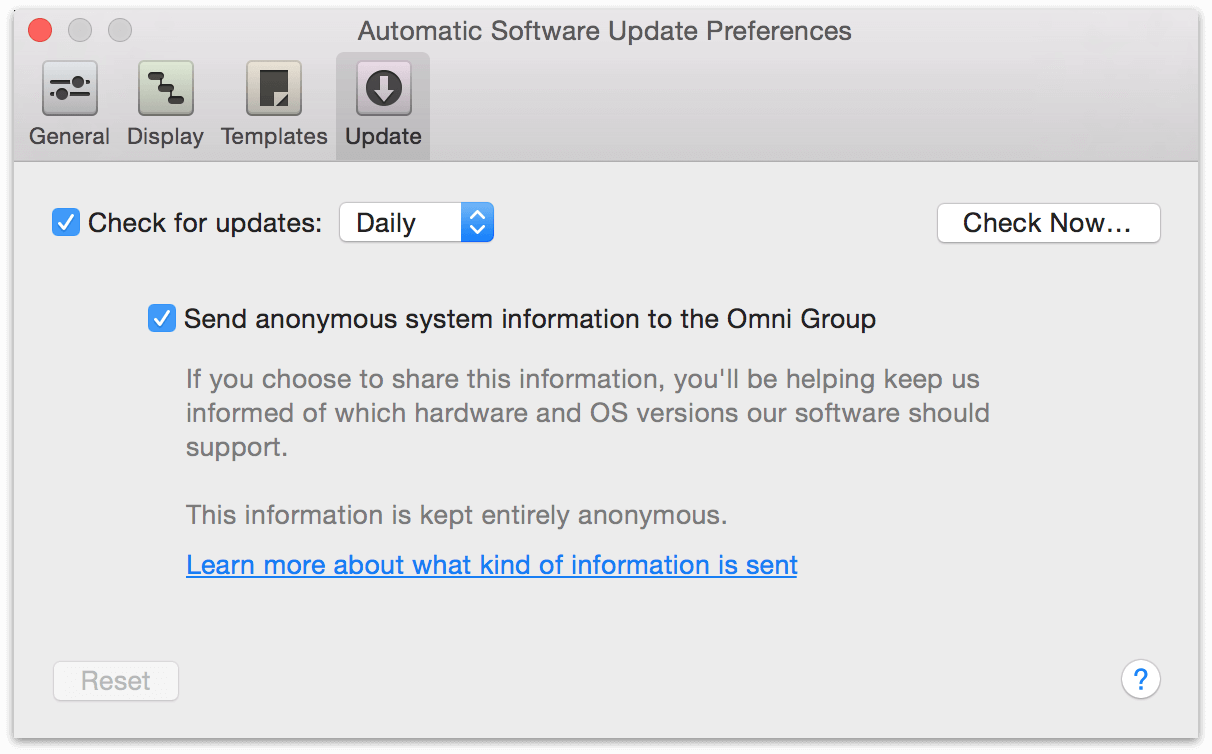
If the Check for Updates checkbox is selected, you will be notified when there is a new version of OmniPlan ready for you to enjoy. Click the Check Now… button to look for the newest version once right away.
You can select the Send anonymous system information to the Omni Group checkbox to volunteer some information about your computer’s configuration when you check for updates. For details about what kind of information we collect and how we use it, click the Learn More link on the preference pane.
